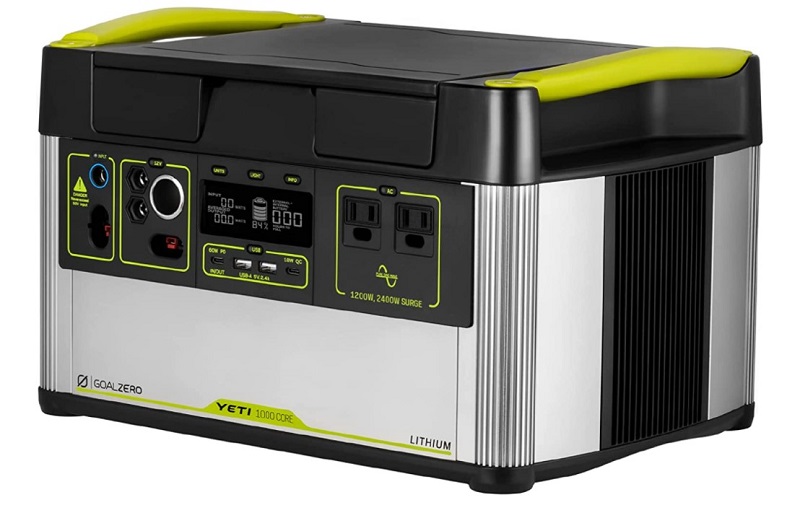Goal Zero is a company that originated out of a philosophy that people should have access to power whenever and wherever they find themselves. The company originated as a solar products company, so it makes good sense that one of the most popular products they make is solar-powered electrical generators. This Goal Zero Yeti 1000 Core review will examine what unique features this power generator brings to the table in an effort to help you decide if this is the right device for you. (>>> Find on Amazon)
Goal Zero Yeti 1000 Core Review of Specifications:
| Goal Zero Yeti 1000 Core | |
|---|---|
 |
|
| Wattage | 1000W |
| Voltage | 120V |
| Capacity | 983Wh |
| Item Weight | 31.68 Pounds |
| Item Dimensions LxWxH | 9.86 x 15.25 x 10.23 inches |
| Price | Check on Amazon |
On paper, the Goal Zero Yeti 1000 Core stacks up well against competitors from companies like Jackery and Bluetti. Goal Zero rates the Lithium-Ion battery pack at an impressive 1,200 watts continuous with surge values up to 2,400 watts. That means that with a fully charged battery, you’ll have the power to run most small appliances and charge devices without worrying about draining the ample power available. Whether you are trying to keep a freezer cold during a power outage, running a CPAP machine while off the grid, or just trying to make a pot of coffee on your next trip to a National Park, the Yeti 1000 has the available juice you need.
Recharge Rates
The biggest limitation to any battery power backup generator is the quickness with which the device can be recharged. This is particularly important when dealing with large power generators like the Yeti 1000 Core. While this device can provide plenty of power, you need to plan ahead to ensure that the device doesn’t discharge completely before you have the ability to recharge it.
The best and fastest way to recharge this device is by using an optional wall charger rated at 230 watts. This type of charger will take about five hours to recharge the device from 20% discharge to 100%. Using the included 100 watt wall charger will take substantially longer -average recharge times are nine hours. That is a substantial amount of time that isn’t going to work for everyone, particularly if the unit is being used to augment an unstable power grid or handle emergency power when wall AC isn’t available. Related comparison: Goal Zero Yeti 1000 Core vs 1000X
Goal Zero -as a solar-based company- did an excellent job designing this unit to recharge using optional solar panels. The design allows for the use of numerous types of solar panels to include fixed panels, folding panels, and portable solar panel kits. You can use up to 300 watts of solar input energy and recharge the Yeti 1000 in as little as five hours, substantially faster than many competitor devices.
The device can also recharge using the 12V accessory port in your car or truck using an optional charging cable. This is a slower method of recharging that can take around 9 hours to fully charge the battery. Keep in mind that your car will need to be running to recharge the unit or your car battery will discharge too quickly.
Pros
- One of the faster solar charging devices
- Good shape and design that puts display and ports on one side
Cons
- Could use more AC options
- Should include charging for 12v
What It Can Power
The most important question many people have when it comes to selecting the appropriate battery backup power generator is whether it has the ability to power important appliances and devices over extensive periods of time. With a total of 1,200 watts on board and a fully charged device, you can expect to be able to power almost anything you’ll want. It will even power a hair dryer for a short period of time, something most designs simply can’t handle due to the high power demands. Need to run a 12v fridge? It’ll handle that task for about 10 hours. Hoping to keep your laptop, cell phone, and drone batteries charged while camping in the wilderness? You’ll be able to be off-grid for about a week without losing power.
Ports for Powering Devices

The focus of this design really is on USB power over AC power. The device provides only two AC ports, so you can only run two devices at once. However, when you need to recharge a cell phone, power a laptop, or use any USB-powered device, the Yeti has you covered. You’ll find four USB ports that include a 60 watt PD port and a USB-C port rated at 18 watts for quick charging of devices. Two USB-A ports allow for lower charging rates required by sensitive, older devices. Three 12 volt ports are also provided to run 12v appliances like mini-fridge or work light stands.
Conclusion
This is a good quality battery power backup for most uses. It provides a level of power that is uncommon in devices of this size, so it will work great for people who need remote access to power. Where it falls a little flat is that the recharging ability requires additional accessories to maximize the ability to get a full charge quickly. (>>> Check on Amazon)